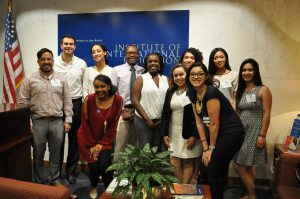
The 2016 cohort of Mount Sinai’s International Exchange Program for Minority Students visiting the Institute of International Education (from left to right, back row): Grant Quiller, Andrew Fisher, Hanna Amanuel, Lanaiar Lett, Waru Gichane, Liz Alvarez, Rayven Plaza, Taylor Jamerson, Mayra Orozco-Llamas; (front row, left to right): Ala Mansour and Natalie Fernandez.
Ten years ago, Athena Fulay, Senior Manager for Institutional Engagement at the Council for International Exchange of Scholars and my longtime outreach colleague from the Fulbright Scholar Program, forwarded a request she’d received to host a pre-departure orientation focusing on Fulbright opportunities for a group of minority graduate students pursuing degrees in the health sciences. Since none of the students held PhDs, and therefore wouldn’t be eligible for Fulbright Scholar opportunities, Athena felt it made more sense for me to handle the request and investigate further. I proceeded to respond to the request and asked the Mount Sinai contact about the composition of the group, the program they represented, and how we could best provide whatever information they needed.
In my subsequent email exchanges, I learned quite a bit: Founded in 2005 by Dr. Luz Claudio, Chief of the Division of International Health at Mount Sinai School of Medicine, the group was called the International Exchange Program for Minority Students. Since its inception, the International Exchange Program for Minority Students has been receiving funding from the National Institute of Minority Health and Health Disparities of the National Institutes of Health (NIH) and in 2010 and in 2015, it was re-evaluated and deemed to be an “outstanding” program at the highest NIH score level.
The program typically receives approximately 400 applications from which they select 10 participants at the BS level; MS and the MD or PhD level. All candidates are currently enrolled or recent graduates and rigorously selected by an outside committee. Upon selection, interns undergo months of preparation, culminating in a week of intensive orientation at Mount Sinai School of Medicine and at the Institute of International Education (IIE).
Right after orientation week, the interns travel to Ireland, Spain, South Africa, Argentina, Mexico or Brazil for three months of research collaboration. Given that previous International Exchange interns often kept in touch with their overseas mentors and extended their work together in the form of collaborative presentations and published papers, Dr. Claudio reached out to IIE to see if presentations on Fulbright and other international exchange programs, offering longer term, more in-depth research opportunities, could be given during the group’s week long orientation. Little did I know that a Fulbright partnership was about to be born which to date, has yielded approximately 10 Fulbright grant recipients!
On June 8, the Fulbright U.S. Student Program and IIE were delighted to once again host 10 Mount Sinai International Exchange Minority Students and share with them not only the basics on how to apply to the Fulbright U.S. Student Program, but also the range of program opportunities available specifically to STEM students as well as information about IIE’s Generation Study Abroad initiative. My IIE colleagues and I were thrilled to meet and work with yet another very talented group of International Exchange minority STEM students, poised to begin their respective overseas internships, some of whom will be traveling outside of the United States for the very first time, and some of whom may very well become Fulbright Students in the near future.


No Comments